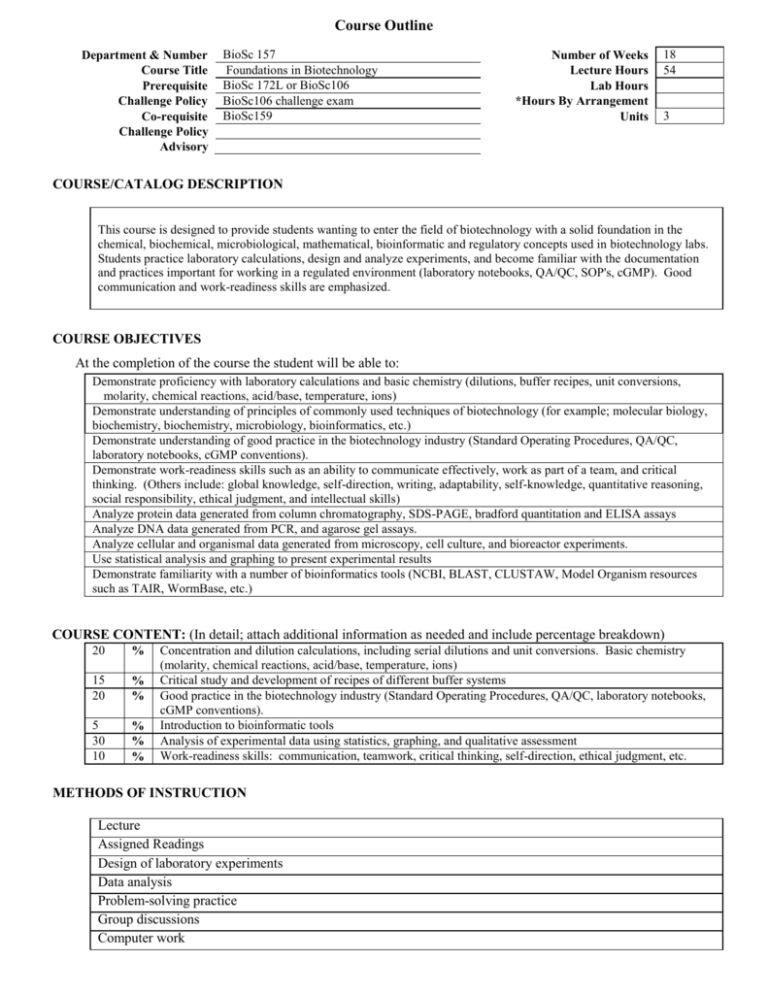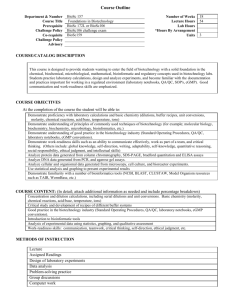Course Outline
advertisement

Course Outline Department & Number Course Title Prerequisite Challenge Policy Co-requisite Challenge Policy Advisory BioSc 157 Foundations in Biotechnology BioSc 172L or BioSc106 BioSc106 challenge exam BioSc159 Number of Weeks Lecture Hours Lab Hours *Hours By Arrangement Units 18 54 3 COURSE/CATALOG DESCRIPTION This course is designed to provide students wanting to enter the field of biotechnology with a solid foundation in the chemical, biochemical, microbiological, mathematical, bioinformatic and regulatory concepts used in biotechnology labs. Students practice laboratory calculations, design and analyze experiments, and become familiar with the documentation and practices important for working in a regulated environment (laboratory notebooks, QA/QC, SOP's, cGMP). Good communication and work-readiness skills are emphasized. COURSE OBJECTIVES At the completion of the course the student will be able to: Demonstrate proficiency with laboratory calculations and basic chemistry (dilutions, buffer recipes, unit conversions, molarity, chemical reactions, acid/base, temperature, ions) Demonstrate understanding of principles of commonly used techniques of biotechnology (for example; molecular biology, biochemistry, biochemistry, microbiology, bioinformatics, etc.) Demonstrate understanding of good practice in the biotechnology industry (Standard Operating Procedures, QA/QC, laboratory notebooks, cGMP conventions). Demonstrate work-readiness skills such as an ability to communicate effectively, work as part of a team, and critical thinking. (Others include: global knowledge, self-direction, writing, adaptability, self-knowledge, quantitative reasoning, social responsibility, ethical judgment, and intellectual skills) Analyze protein data generated from column chromatography, SDS-PAGE, bradford quantitation and ELISA assays Analyze DNA data generated from PCR, and agarose gel assays. Analyze cellular and organismal data generated from microscopy, cell culture, and bioreactor experiments. Use statistical analysis and graphing to present experimental results Demonstrate familiarity with a number of bioinformatics tools (NCBI, BLAST, CLUSTAW, Model Organism resources such as TAIR, WormBase, etc.) COURSE CONTENT: (In detail; attach additional information as needed and include percentage breakdown) 20 % 15 20 % % 5 30 10 % % % Concentration and dilution calculations, including serial dilutions and unit conversions. Basic chemistry (molarity, chemical reactions, acid/base, temperature, ions) Critical study and development of recipes of different buffer systems Good practice in the biotechnology industry (Standard Operating Procedures, QA/QC, laboratory notebooks, cGMP conventions). Introduction to bioinformatic tools Analysis of experimental data using statistics, graphing, and qualitative assessment Work-readiness skills: communication, teamwork, critical thinking, self-direction, ethical judgment, etc. METHODS OF INSTRUCTION Lecture Assigned Readings Design of laboratory experiments Data analysis Problem-solving practice Group discussions Computer work INSTRUCTIONAL MATERIALS Textbook Title: Author: Publisher: Edition/Date: Textbook Title: Author: Publisher: Edition/Date: Foundations in Biotechnology Lab and Lecture Workbook Katherine Krolikowski Note: This lab and lecture workbook was generated by CCC faculty 3rd Edition, 2013 Basic Laboratory Methods for Biotechnology Lisa A. Seidman and Cynthia J. Moore Pearson/Benjamin Cummings 2nd (2009) COURSE EXPECTATIONS (Use applicable expectations) Outside of Class Weekly Assignments Weekly Reading Assignments Weekly Writing Assignments Weekly Math Problems Lab or Software Application Assignments Other Performance Assignments Hours per week 1 2 3 STUDENT EVALUATION: (Show percentage breakdown for evaluation instruments) 35 30 35 % % % Calculation and recipe assignments Quizzes Experimental design and data analysis assignments GRADING POLICY (Choose LG, CR/NC, or SC) X Letter Grade 90% - 100% = A 80% - 89% = B 70% - 79% = C 60% - 69% = D Below 60% = F Pass / No Pass 70% and above = Pass Below 70% = No Pass Prepared by: Katherine Krolikowski, PhD Content Review Date: October 2013 Revised 04/13 Student Choice 90% - 100% = A 80% - 89% = B 70% - 79% = C 60% - 69% = D Below 60% = F or 70% and above = Pass Below 70% = No Pass




